Meistergesang is German poetry for singing to melodies. The Meistersinger were mostly burghers of the 14th, 15th, and 16th c. and were organized into guilds on a hierarchical basis. In effect one graduated to the rank of Meister. The meetings were informal occasions and the songs were for the most part religious, didactic, and moral. In this respect, they differed from the Minnesingers whose literary descendants they were. The Meistersinger maintained and developed the traditions of the medieval Minnesingers. They belonged to the artisan and trading classes of the German towns and were regarded as their masters and the founders of their guild of twelve poets of the Middle High German period, which included Wolfram von Eschenbach, Konrad von Würzburg, Reinmar von Zweier, Heinrich Frauenlob and others.
Meistersingers were particularly common in southern Germany and in the Rhineland. Two of the most famous were Hans Folz and Hans Sachs. The plot of Richard Wagner’s 1868 opera Die Meistersinger von Nürnberg revolves around the guild of Meistersingers and their singing contest.

Leave a Reply